Introduction
Alabeo launched as a sister company to Carenado in December 2011
with the aim of "bringing a different type of flying experience
to people who may otherwise never get the chance to experience
it". With "lower priced" aircraft, Alabeo products "combine the
joy, the challenge, and the fun of flying".
Quickly establishing themselves with the development and regular
release of aircraft which differ from the normal add-on aircraft
range, Alabeo have created somewhat of a niche market and set a
new benchmark in aircraft add-ons for FSX and other flight
simulators. The release of Alabeo's Cessna 172RG 'Cutlass II'
continues this development focus and provides an opportunity to
look more closely at the product they produce.
History
With more built than any other aircraft, the Cessna 172
‘Skyhawk' model range is the most successful aircraft in history
and can be measured by it's longevity and popularity. Developed
as part of the Cessna 172 model range, the 172RG 'Cutlass' was
introduced in 1980.
The Cessna 172RG 'Cutlass' is a four seat, single engine,
general aviation aircraft. It has a strut braced, high wing with
a retracting, tricycle landing gear. The role of the 172RG
'Cutlass' was intended to meet the specific requirements for
"complex aircraft" experience necessary to obtain a Commercial
Pilot certificate and the aircraft has been adopted by many
flight schools for this purpose. Its relatively low operating
cost made it perfectly suited to the role and it produced an
optimal cruise speed approximately 20 knots above the equivalent
standard model at the time. Production of the 172RG 'Cutlass'
ran from 1980 to 1985 and resulted in approximately 1,200 units
being produced.
Availability and Installation
The Alabeo Cessna 172RG 'Cutlass II' is currently available
direct from Alabeo and Alabeo resellers as a 'download only'
product (some resellers also offer a master back-up CD / DVD
service for a minor additional cost). It is priced at US$22.95,
or the equivalent on currency cross rates. The file size of
146MB is reasonable for an aircraft of this type and quality and
it requires 330MB of HDD space for installation. Depending on
where it was purchased, an ‘activation key' may be issued to be
used during installation.
Documents
There are four manuals / documents provided in Adobe Acrobat
format (.pdf):
● Normal Procedures – this nine page manual
provides the procedures for the normal operation of the
aircraft;
● Emergency Procedures – this nine page
manual provides the procedures for the emergency operation of
the aircraft;
● Performance Tables – this seven page
document details the operating cruise performance specifications
of the aircraft; and
● Reference – this one page document details
the performance specifications of the aircraft.
Model Features
With a basic avionics suite, the Cessna 172RG 'Cutlass II' is
fundamentally a solid, rudimentary, general aviation aircraft
and it is this aspect on which Alabeo have focused development
attention. This aircraft is about the simple experience and pure
pleasure of general aviation flying and this is exactly what you
get with Alabeo's rendition of the 172RG 'Cutlass II'.
This review has involved over 20 hours of specific flight
testing flying hours and it is evident Alabeo have delivered an
aircraft in the 172RG 'Cutlass II' which focuses solidly on
achieving their intent of combining the joy, the challenge, and
the fun of flying.
The model features listed by Alabeo for the 172RG 'Cutlass II'
are typical of models in the Alabeo range and include:
● HD quality textures;
● High quality 3D model and textures;
● Material shines and reflections;
● Gauge reflections;
● Windows scratches (crazing) and blade
shines; and
● Realistic behaviour.
There is a single model provided (two pilots), five HD paint
schemes and a blank texture provided for aircraft painting
enthusiasts.
General Visual Appearance
Exterior. Alabeo's Cessna 172RG 'Cutlass II'
displays a high level of attention to accuracy and detail. A
comparative review of photographs of real world aircraft to
Alabeo's rendition reveal the exterior shape and dimensions to
be highly accurate and a true representation of the real world
aircraft. Noted differences were minor and are considered to be
related to real world production variations and / or developer
latitude for the level of modelling adopted for the Alabeo
aircraft range.
Interior. Consistent with the exterior, the
general appearance of the cockpit and the panel layout are also
modelled to a very high degree of detail. However, with so many
avionics fit out options available, I was unable to find a real
world photograph which matched the exact panel layout modelled by Alabeo. Nonetheless, when compared to real world photographs of
similar layouts, the cockpit and panel layout are modelled to a
high degree of accuracy.
Paint Schemes. There are five individual paint
schemes provided with the 172RG 'Cutlass II' and each aircraft
has a unique aircraft registration number. The surface textures,
reflections, and shadings give the aircraft a crisp and
realistic appearance.
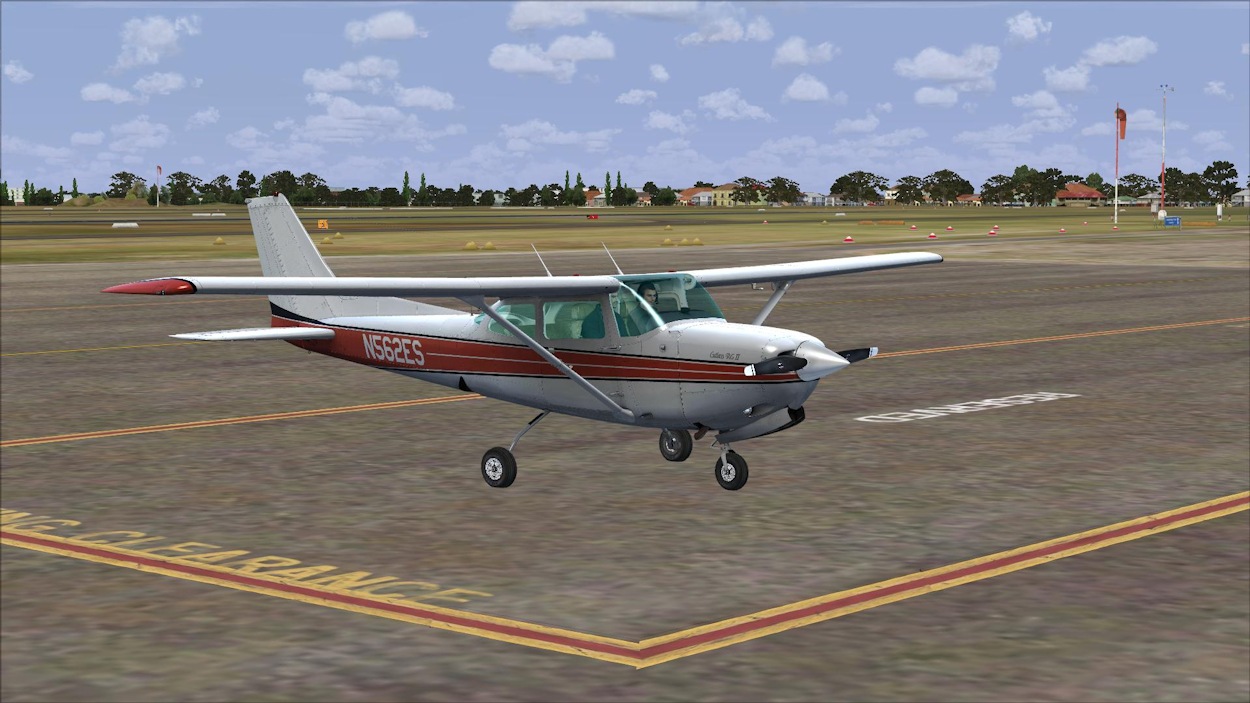 Paint Scheme 1 |
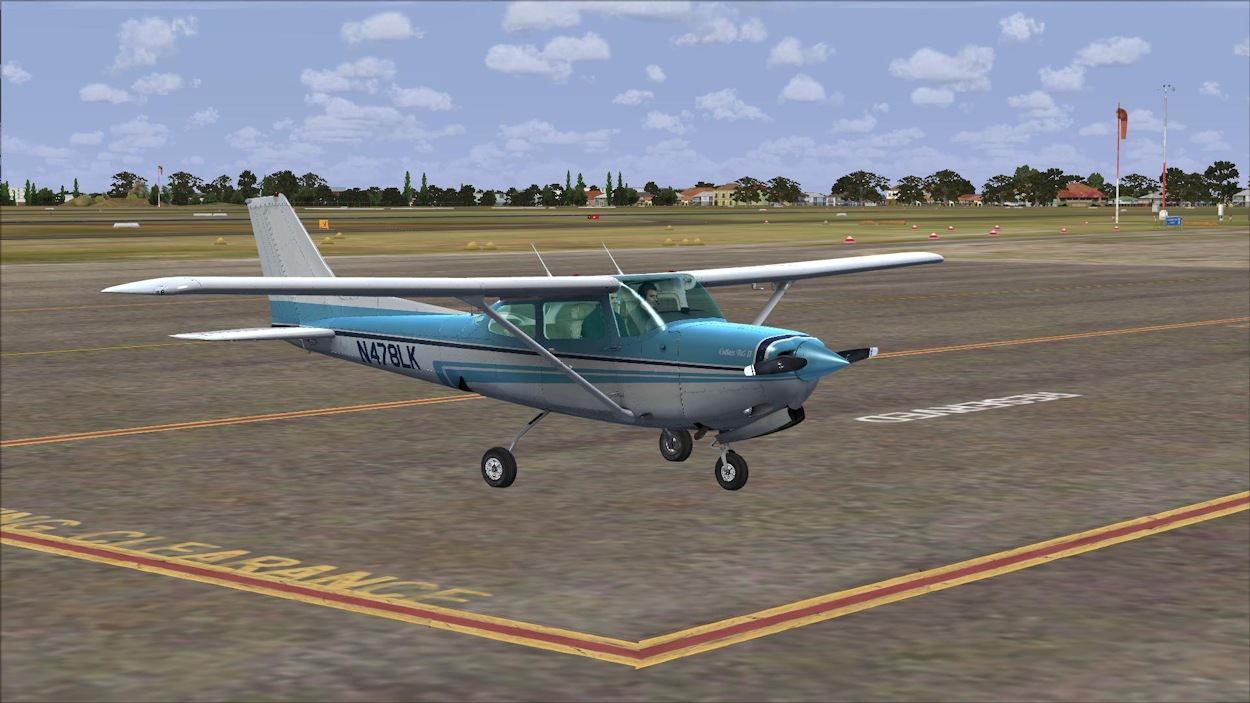 Paint Scheme 2 |
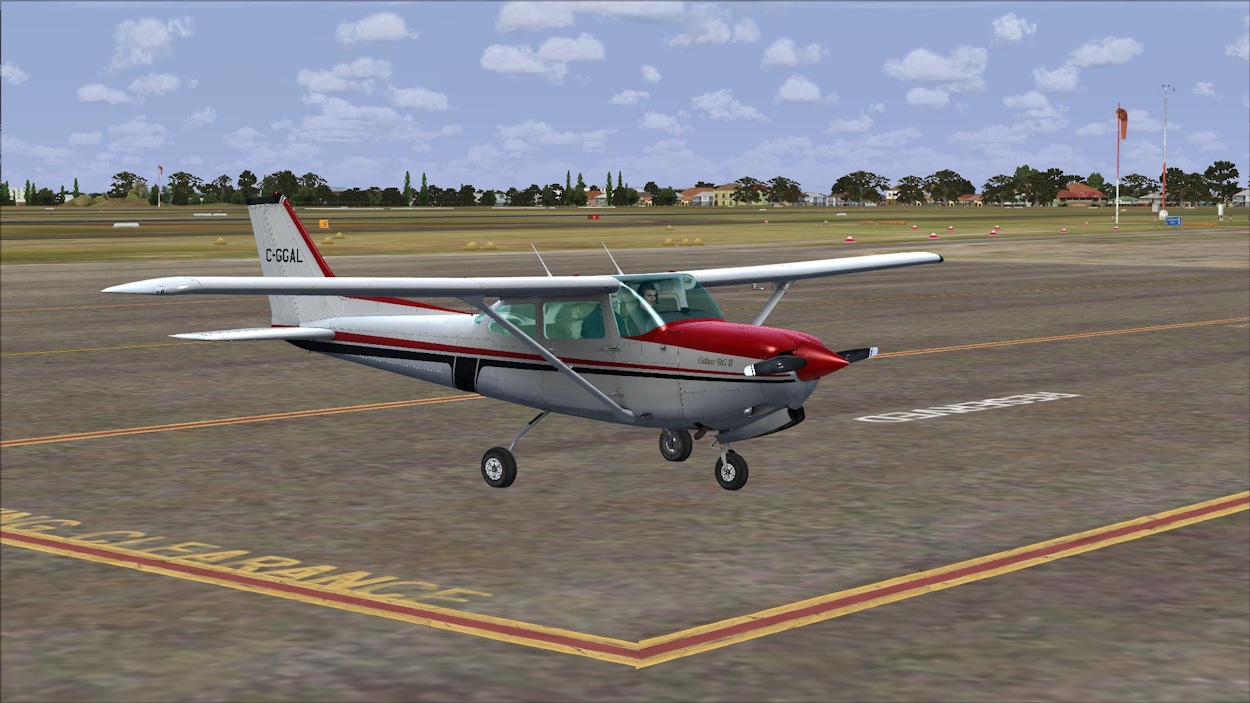 Paint Scheme 3 |
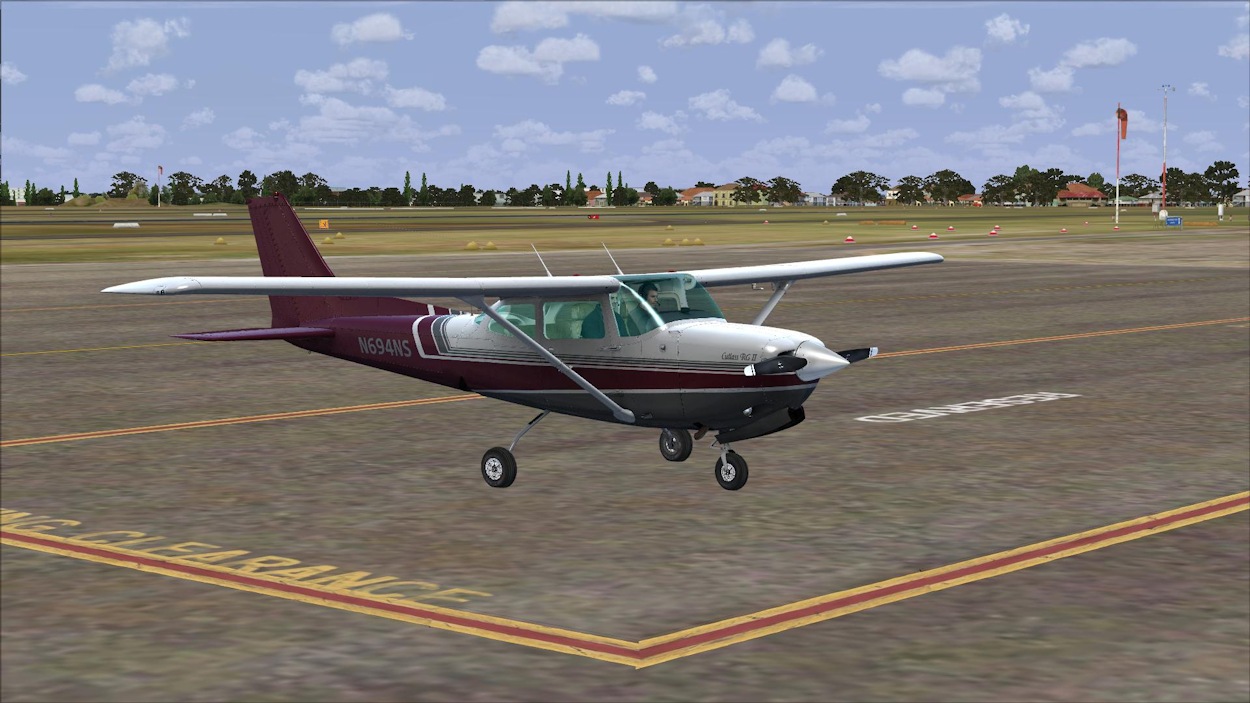 Paint Scheme 4 |
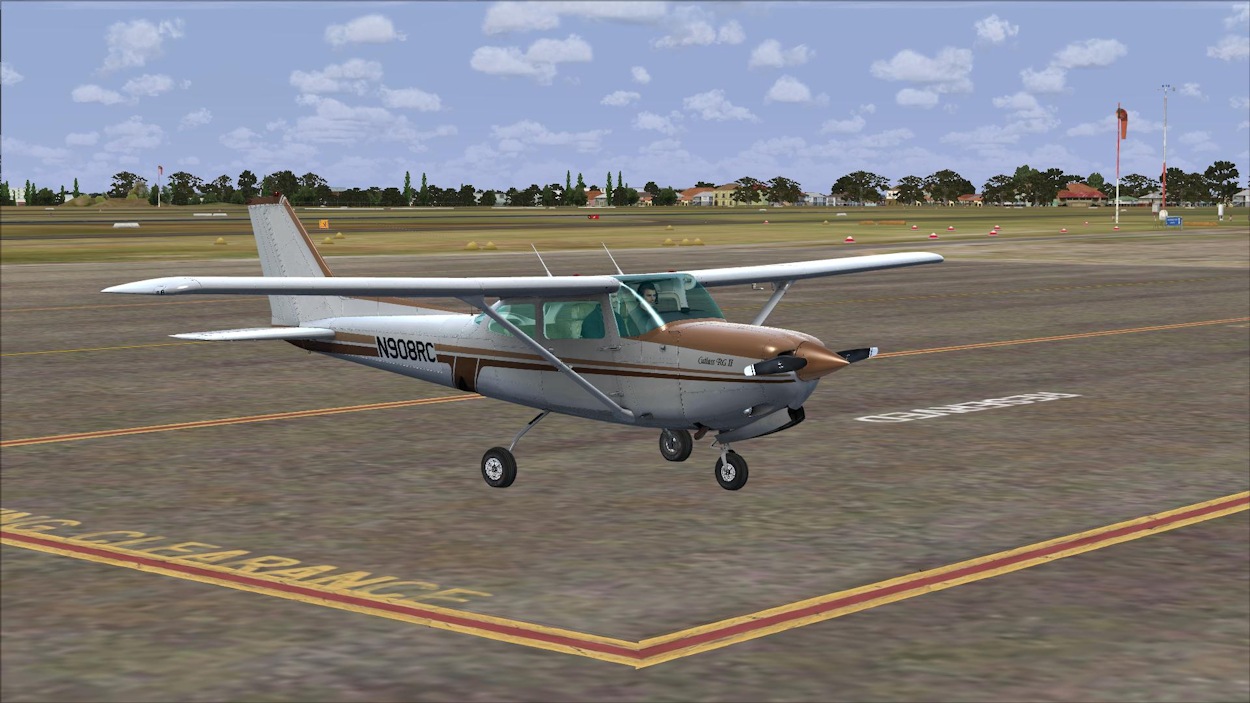 Paint Scheme 5 |
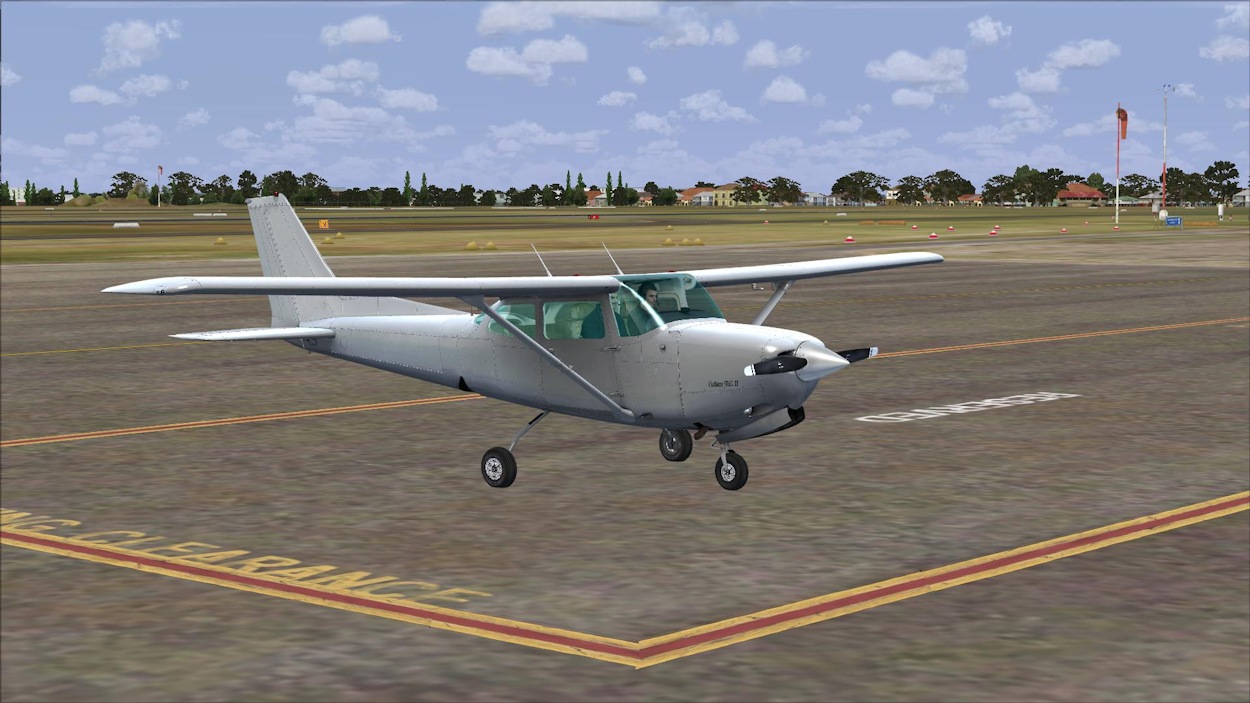 Paint Scheme 6 |
Exterior
For the price point for the 172RG 'Cutlass II', Alabeo have set a benchmark for modelling accuracy and detail on the aircraft's exterior. The level of this detail includes individual fuselage panels, panel access screws, panel rivets, various aerials and antenna, fuel tank caps, grab handle and foot step plates to access the fuel tanks on the wings, and vortex generators on the vertical stabiliser. Exhaust and oil stains on the fuselage add to the overall realistic appearance.
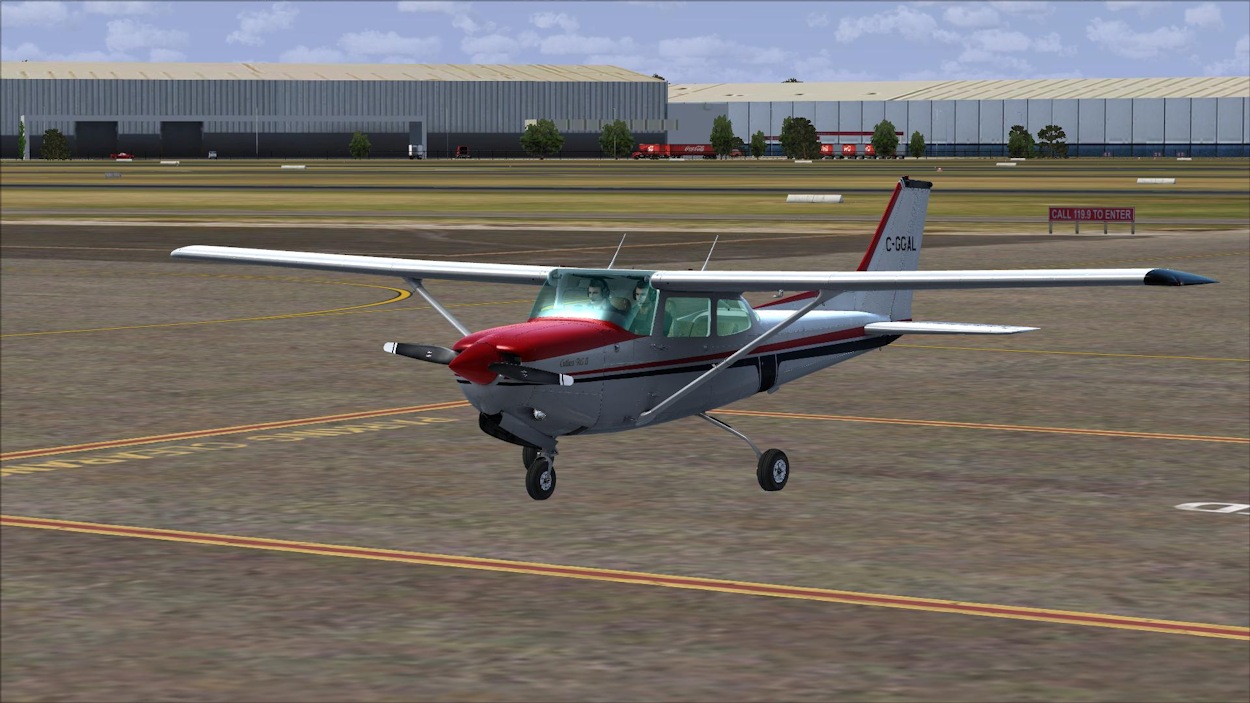 External General View |
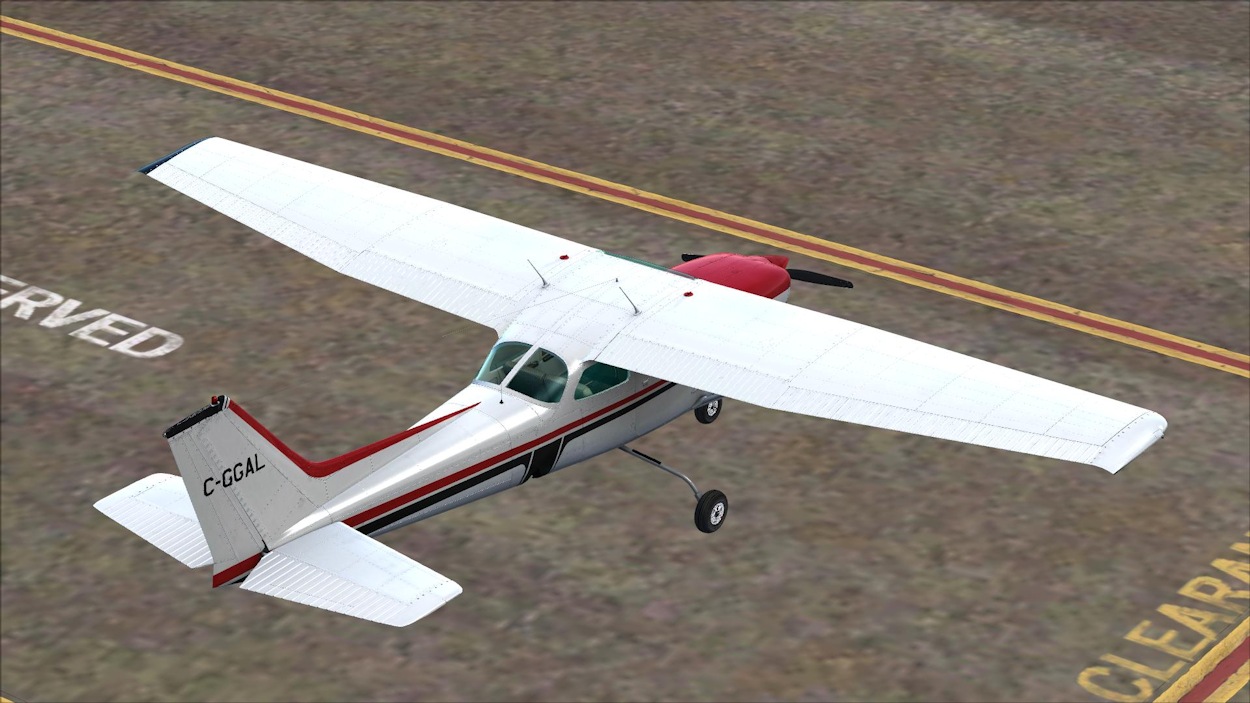 External Top View |
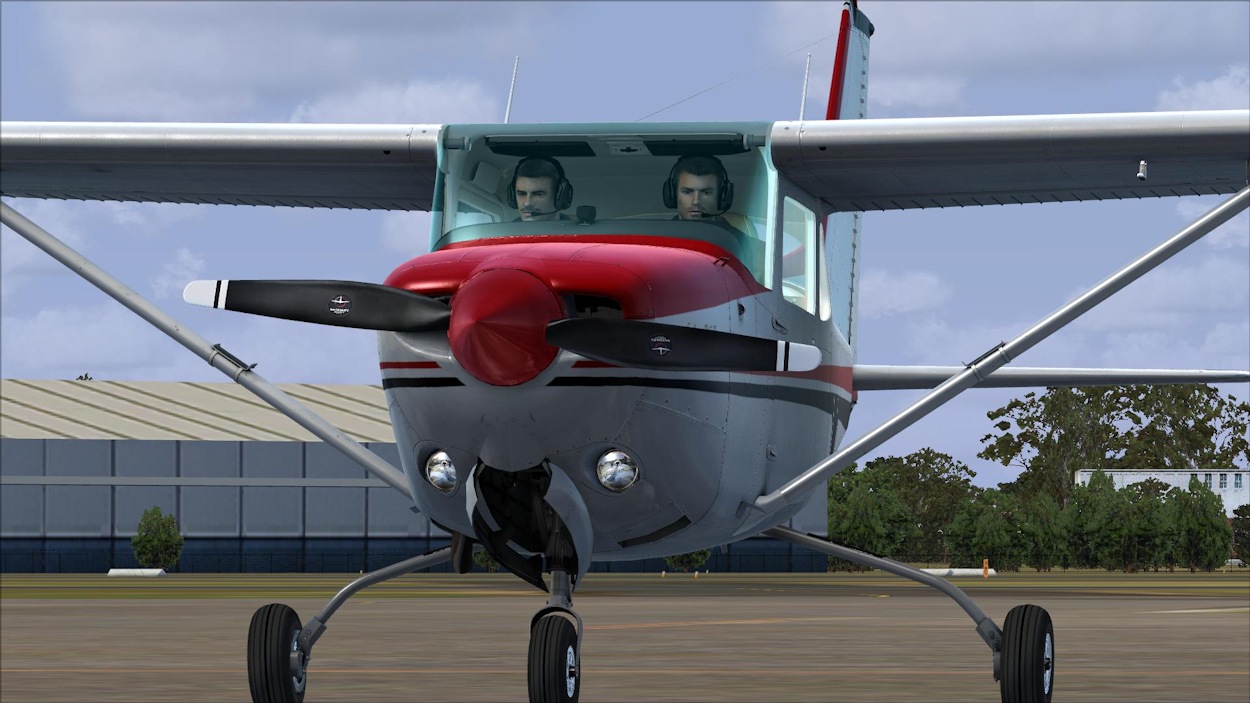 Nose View |
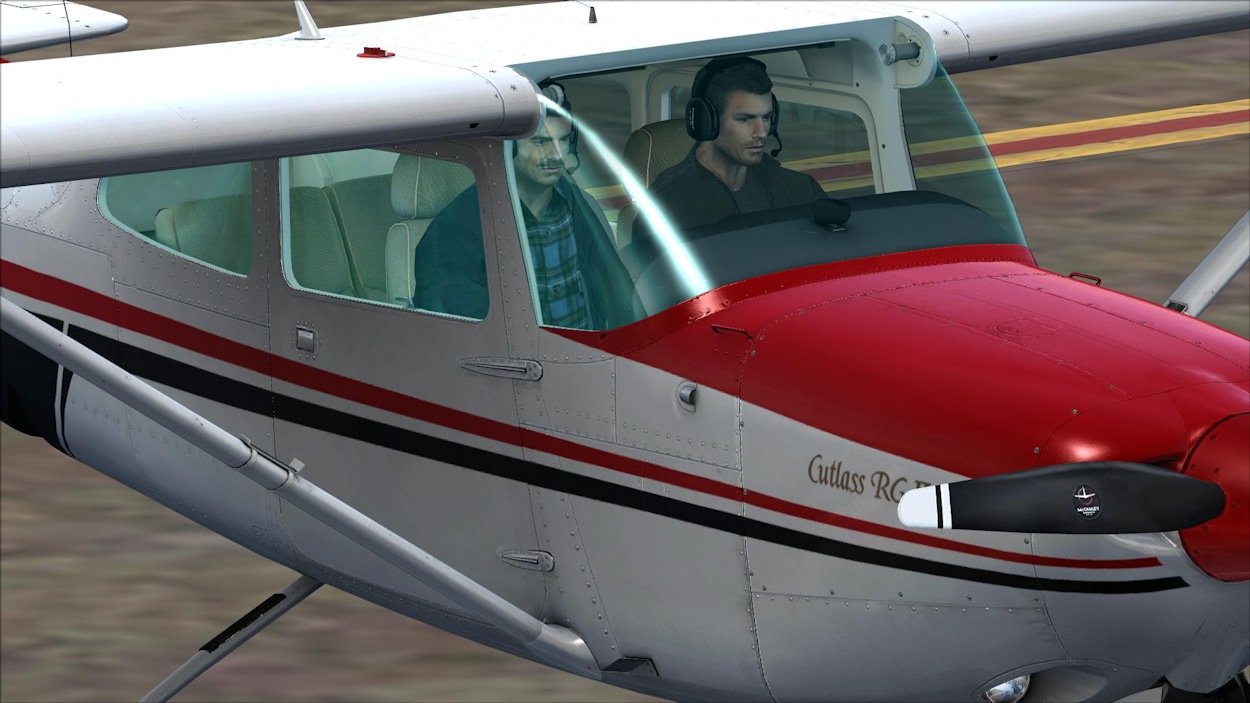 Grab Handle & Foot Step Plate |
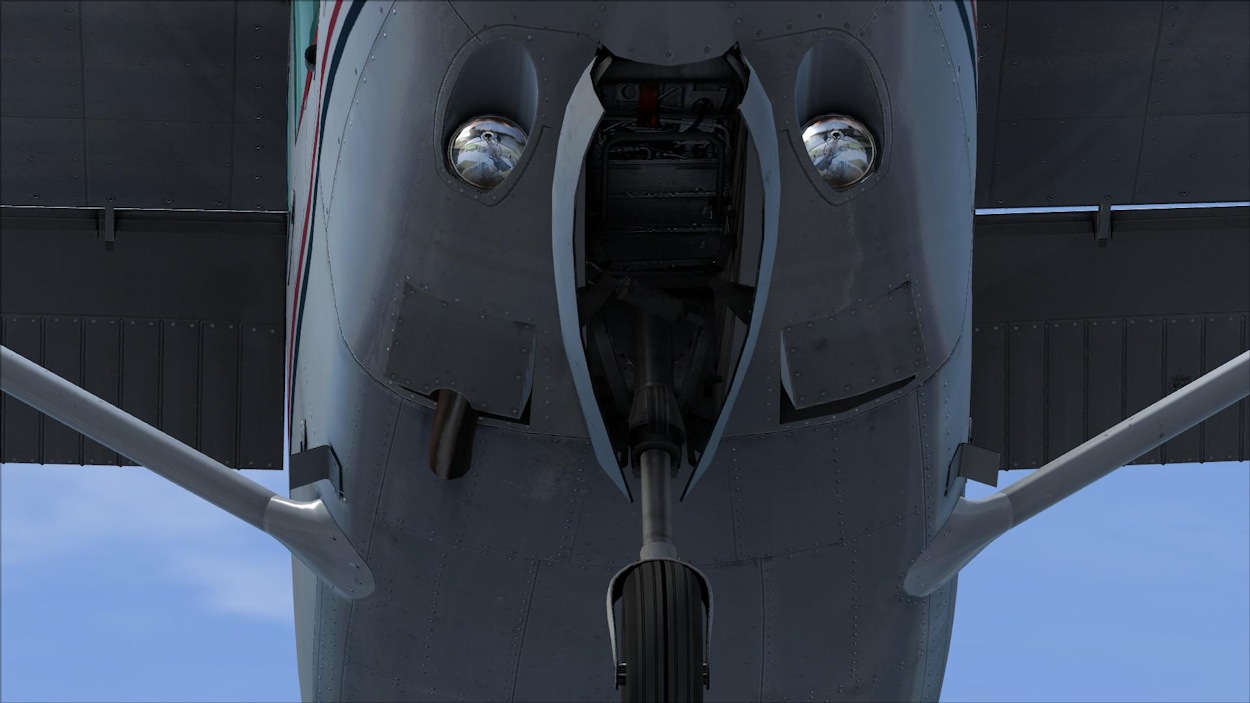 Nose Wheel Detail |
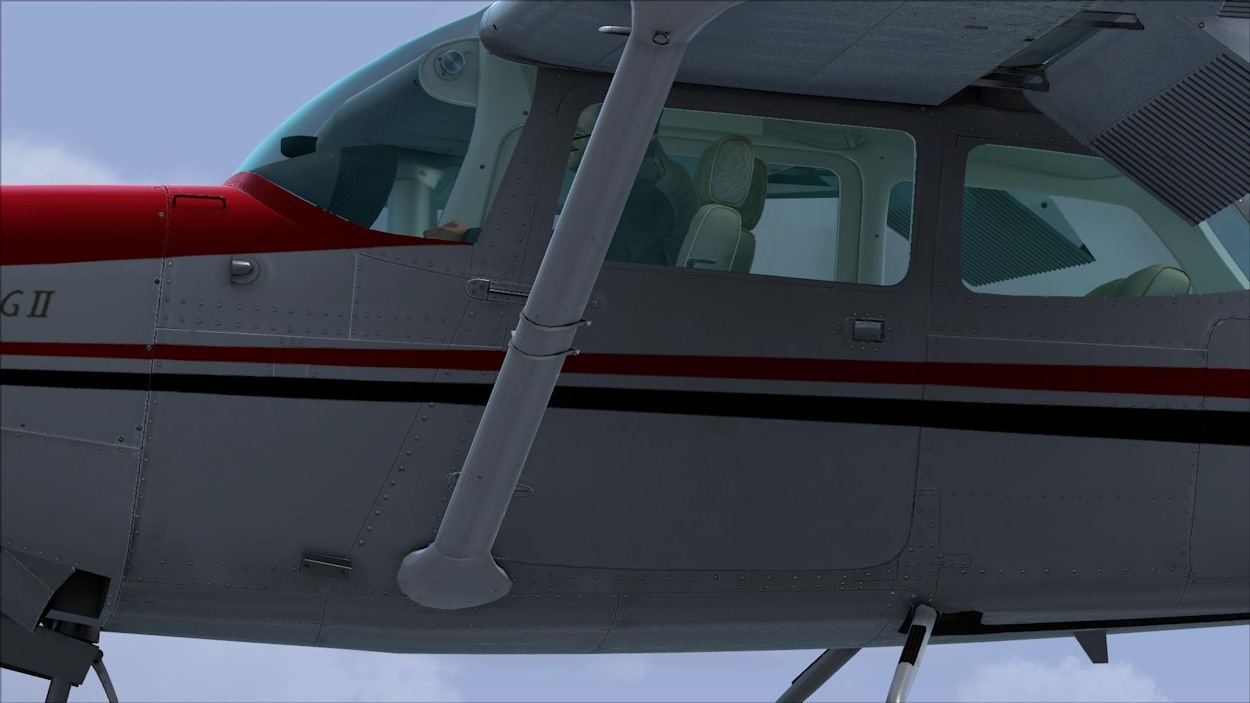 Side Fuselage Detail |
Alabeo’s rendering of the cockpit of the Cessna 172RG 'Cutlass II' is also good and very realistic when compared to real world layouts.
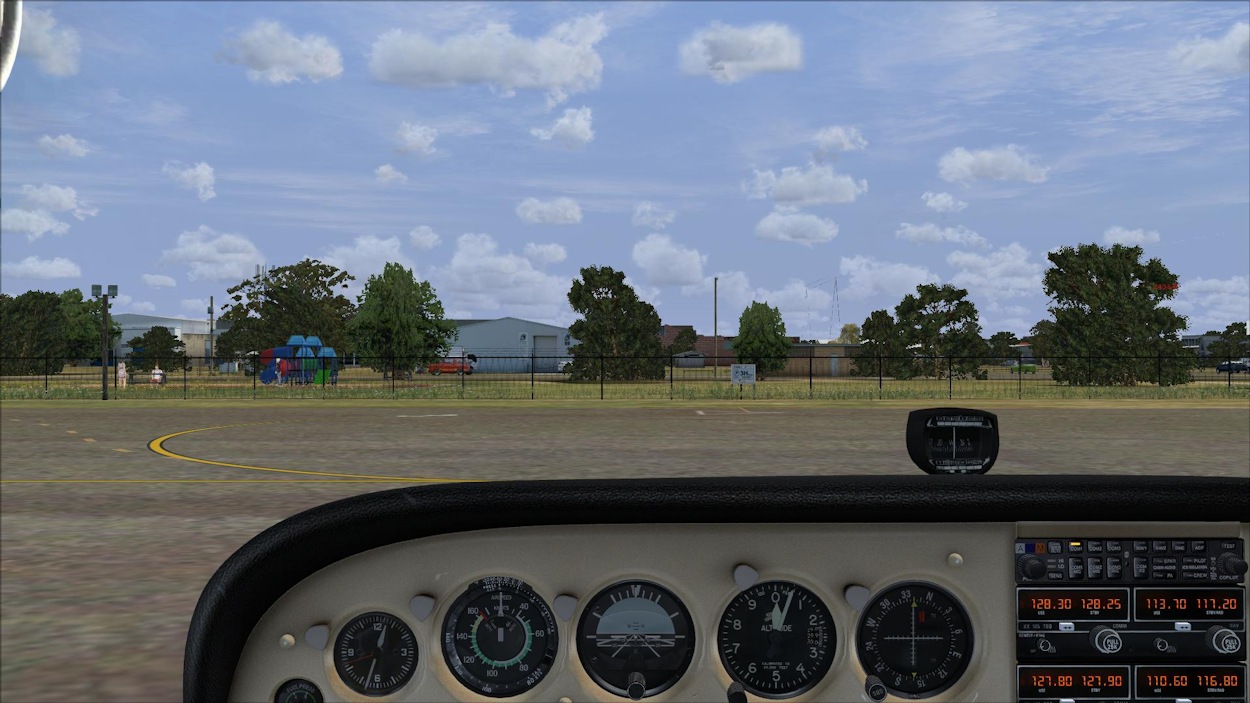 Virtual Cockpit View |
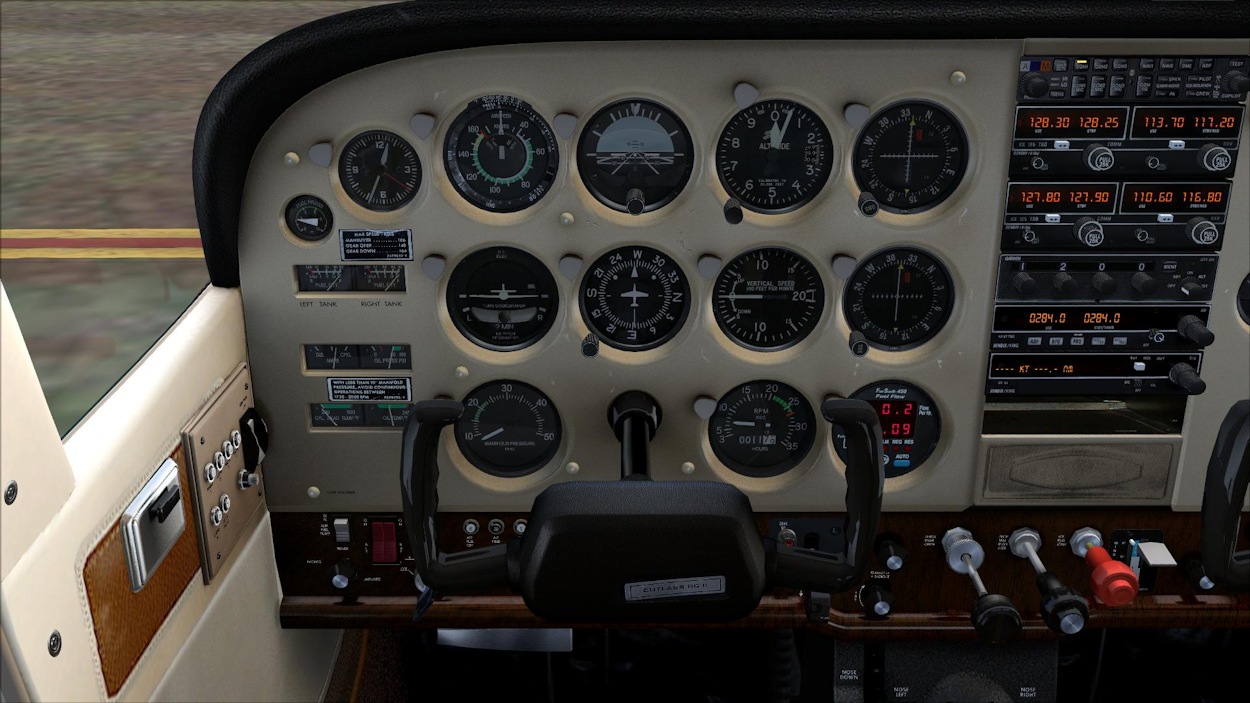 Detailed Panel View, Left Side |
Instruments and Panel Layout. All primary flight instruments and engine management instrumentation in the 172RG 'Cutlass II', are on the left side (pilot side) with only the ADF receiver, EGT gauge, suction gauge, and Hobbs meter on the right side of the panel. The COM and NAV radios, transponder, ADF receiver, DME, throttle, trim controls, and fuel tank selector are all located centrally. The primary flight instruments are laid out in the standard “T” and "six pack" arrangement and all the flight instruments are clear and easy to read and have the option for instrument glass reflections to be enabled or disabled. The removal of both yokes can be toggled to provide an unobstructed view of the panel, particularly of the ignition and light switches located on the lower panel. Various alternative cockpit camera views are available to provide more detailed views of the instruments. The panel dashboard has a textured finish resembling that of textured vinyl. Unlike the other COM and NAV radios, which use a rotating knob for tuning, the tuning of the ADF Receiver is done using click spots. The size of these click spots is small and can sometimes be difficult to locate, particularly at reduced zoom levels. There are also no checklists or aircraft reference data provided on the 'Kneeboard'.
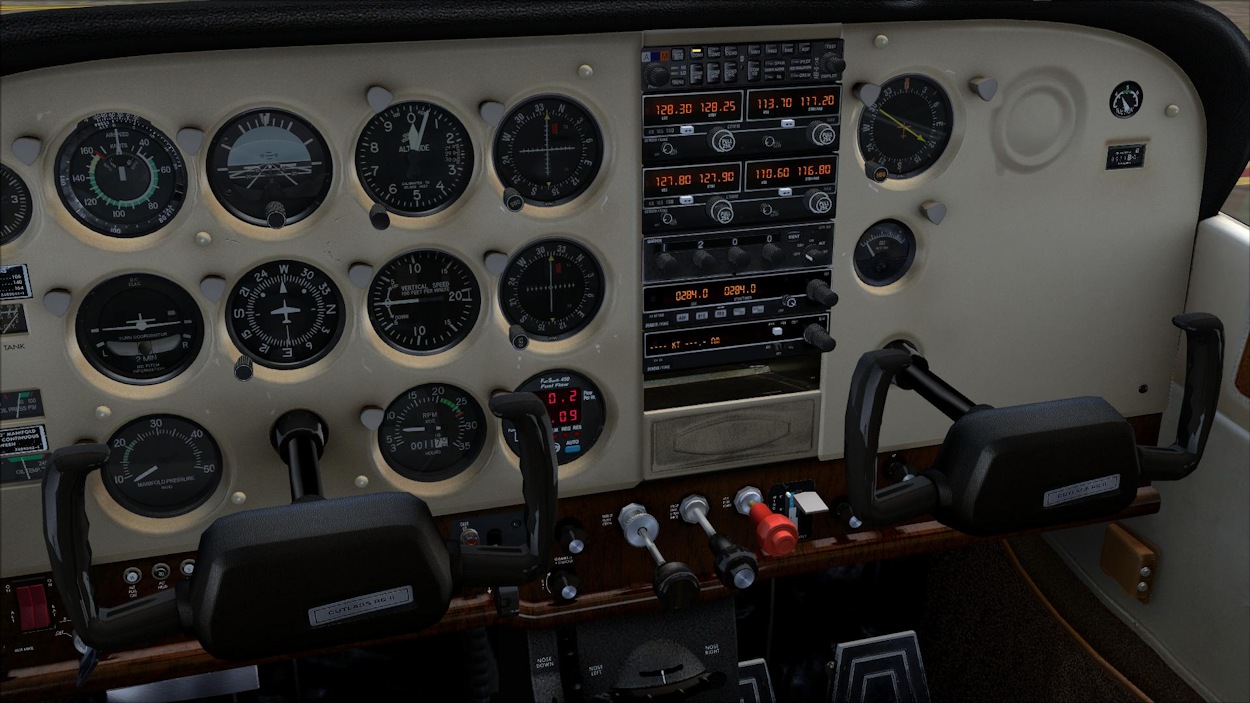 Detailed Panel View, Right Side |
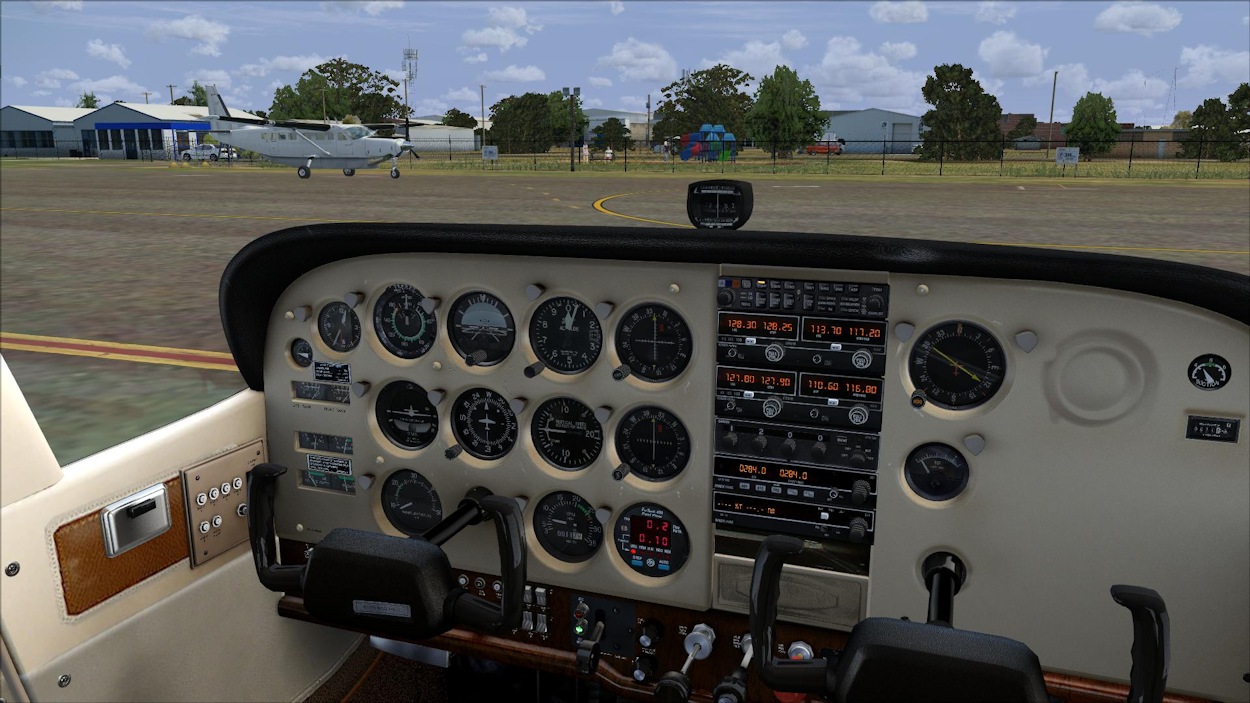 Cockpit, Right Seat View |
Overall though, the attention to detail on the interior is, again, of a high quality.
Animations
The animations of the primary and secondary control surfaces and other moving elements on Alabeo's 172RG 'Cutlass II' are all modelled faithfully. In particular, the retractable main landing gear displays the peculiar operation involving a multi stage retraction and deployment. Initially, the main gear moves to a ‘dangling’ position and pauses before it begins a rearward movement to retract into the gear wells and the reverse during deployment.
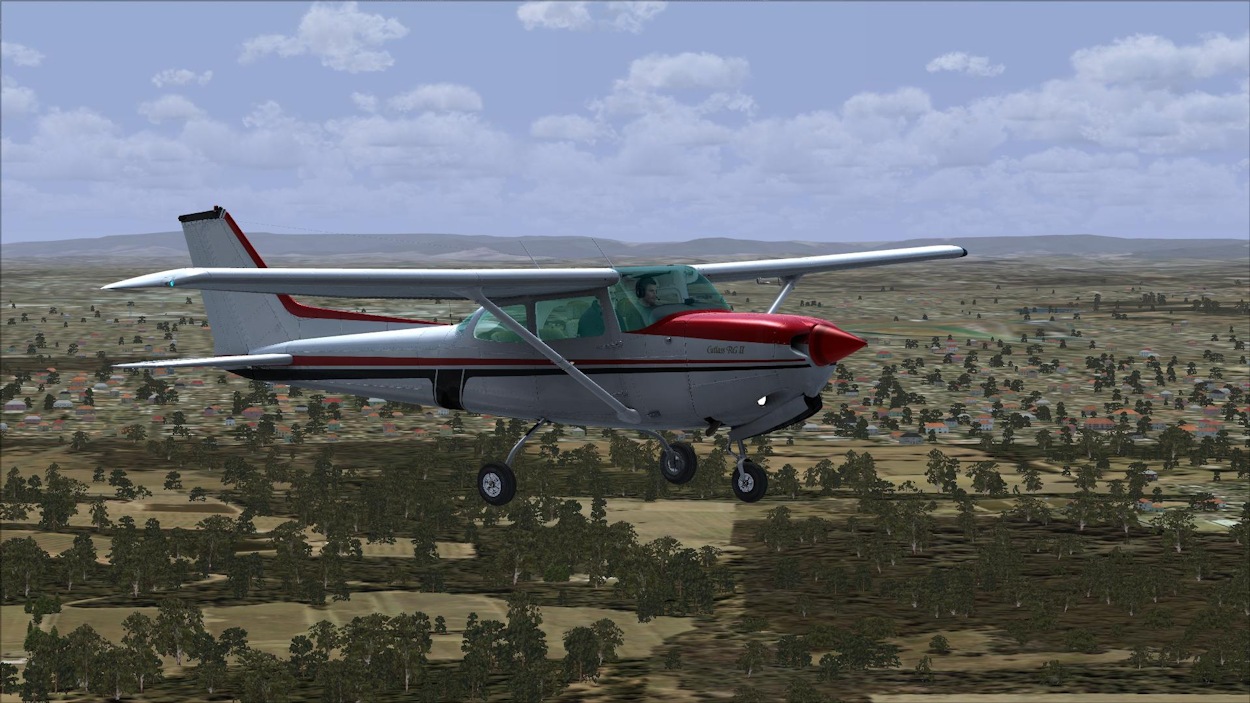 On Take-Off |
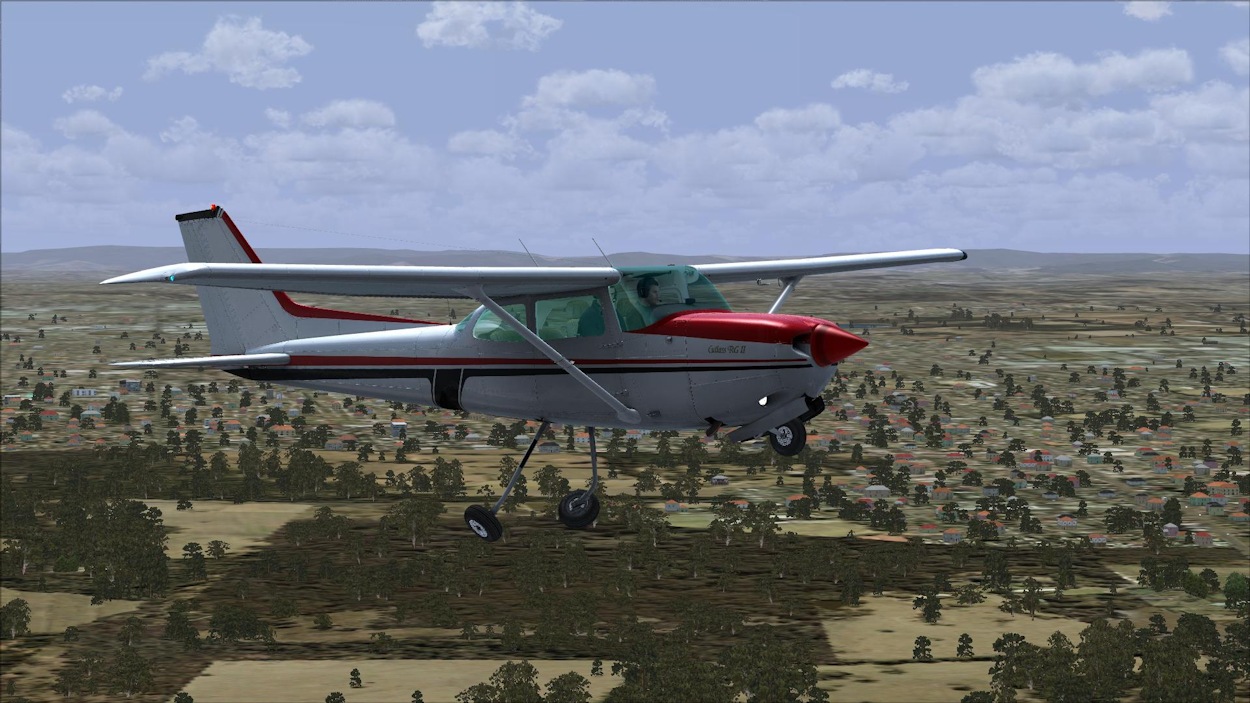 Gear Retracting |
● Primary control surfaces – ailerons, elevators and rudder;
● Secondary control surfaces – flaps;
● Others – retractable gear, elevator trim tab, rolling wheels, pilot and passenger door open / close, windows open / close, sun visors,
and external air flow vents; and
● Pilot head movement.
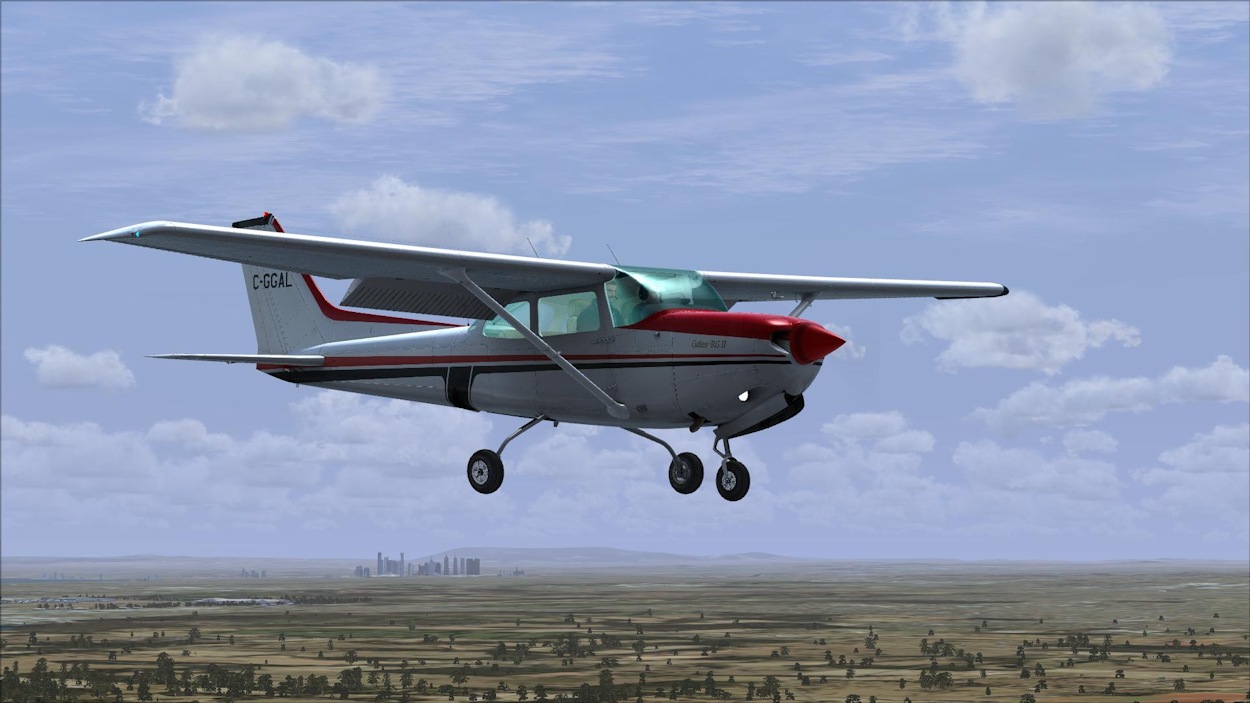 Landing Configuration 1 |
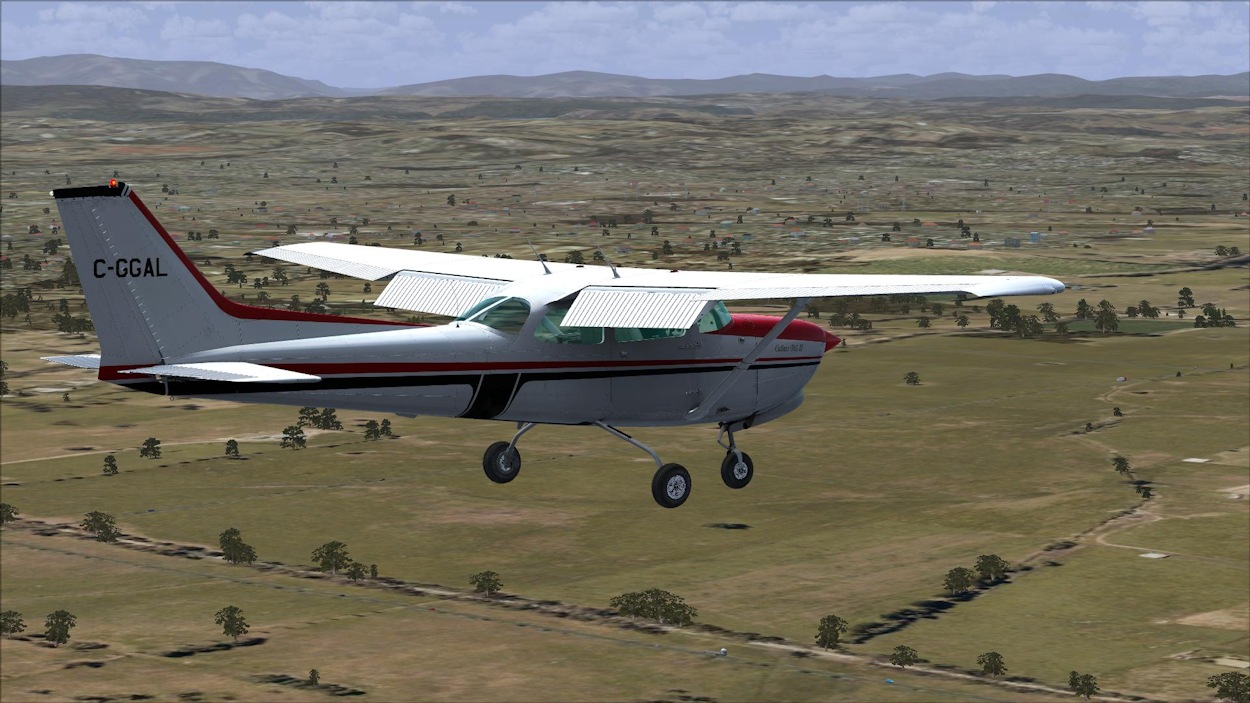 Landing Configuration 2 |
Alabeo have done a credible job on the lighting and lighting effects on the 172RG 'Cutlass II' and they provide a good, realistic representation of the real world aircraft. There is the usual navigation lights, rotating beacon, strobe lights, taxi and landing light, and panel and cabin interior lighting. Other than the taxi, and landing lights illuminating the ground effectively, the strobe lights also provide this illuminating effect. Of additional, particular note is the strobe light effect, which replicates the true asynchronous flash effect of these lights. However, whilst there is the asynchronous flash of the lights, the corresponding illumination of the ground does not replicate this asynchronous flash. The detailed night light effects for the instrument panel and the cockpit, generally, are very good and replicate the night lighting seen in photographs of real world aircraft. All interior lighting effects can be seen when viewing the aircraft from an external view.
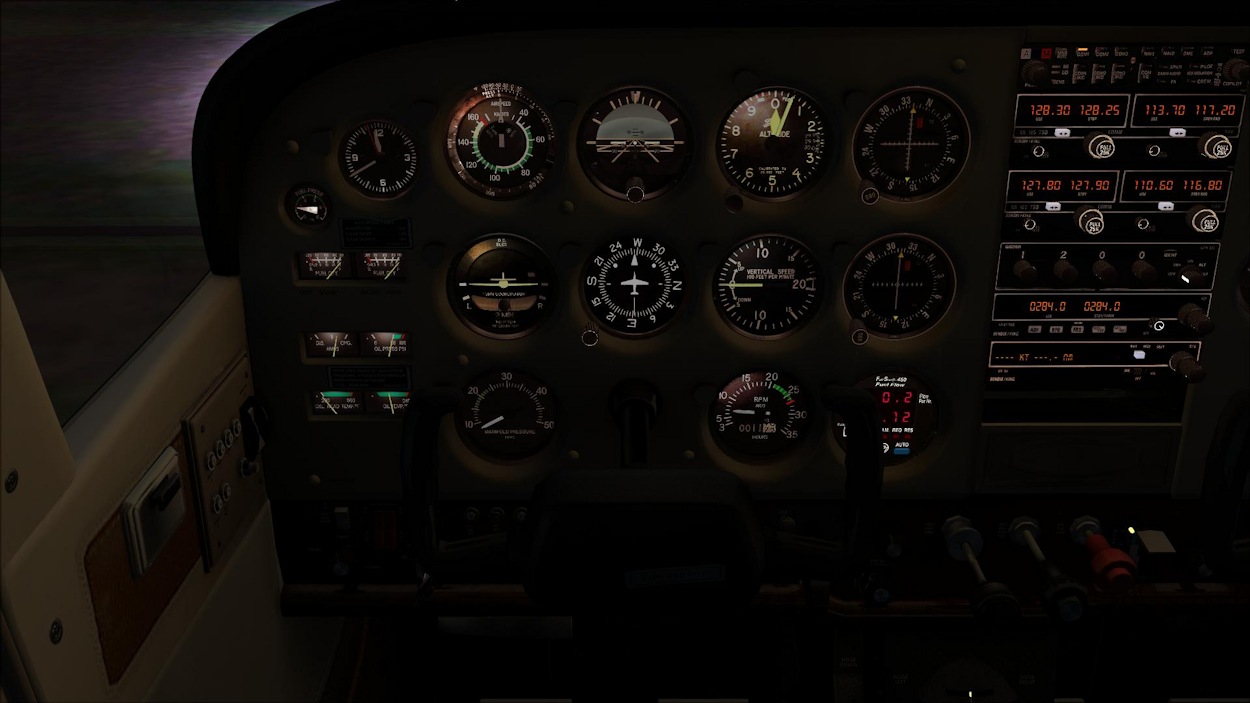 Detailed Panel View, Night |
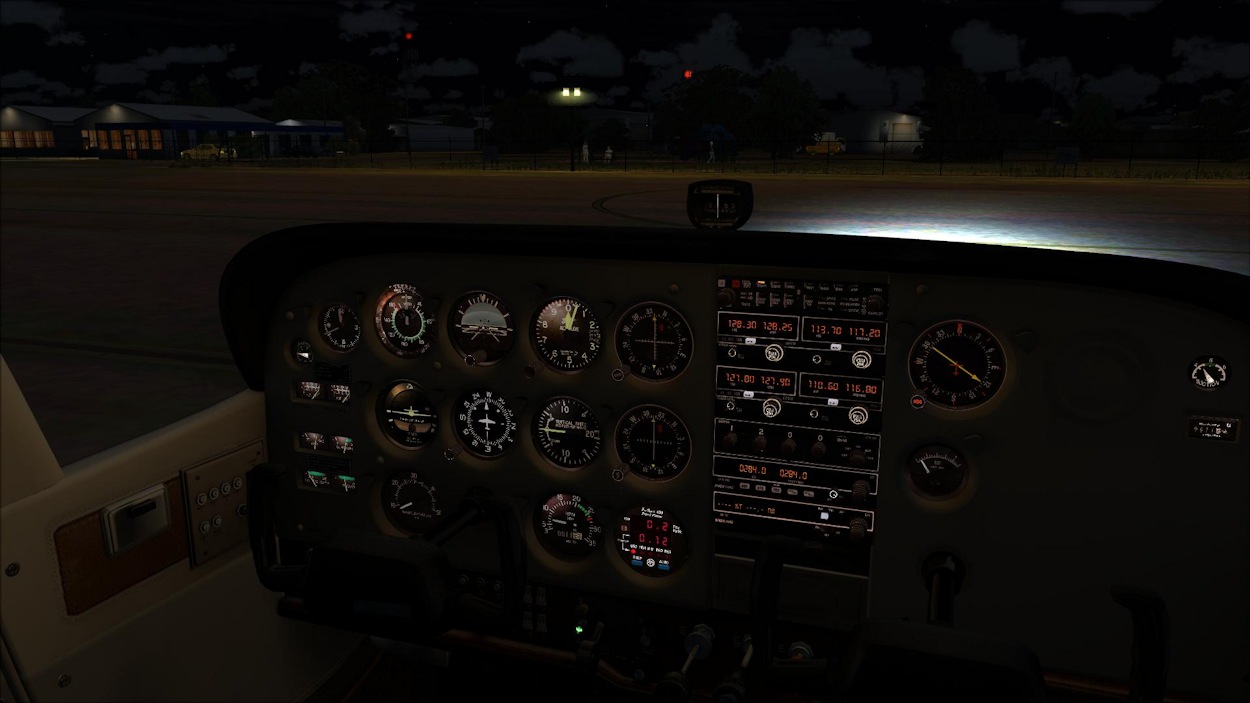 Cockpit, Right Seat View, Night |
The sounds on Alabeo's 172RG 'Cutlass II', are reasonably realistic and representative of the real world aircraft. The engine exhibits a throaty rumble on start up before settling into a steady burble sound during idle. As the throttle is increased for take-off, the engine quickly adopts a strong steady 'thrum' which then settles to a 'humming' sound as the aircraft is configured at cruise.
The sounds associated with the gear and flaps during their respective deployment and retraction phases are realistic and a gear warning sound activates when the throttle is reduced to idle whilst the gear is still retracted. Other generic sounds include switch sounds and sounds associated with the doors opening and closing.
General Characteristics and Performance Specifications
The general characteristics and performance specifications for the Cessna 172RG 'Cutlass II' are provided in the table. This is based on data from the Cessna web site, data in the aircraft details provided by Alabeo, and general research sources. Some of this data varies between sources and also may be an approximation due to variances in data and the specific aircraft modelled by Alabeo.
 |
Flight Performance
A specific Test Flight was conducted from Essendon (YMEN) to Casino (YCAS) to test the flight performance of Alabeo's Cessna 172RG 'Cutlass II'. The flight was conducted in clear weather with a full fuel load, the aircraft at maximum take-off weight (MTOW), and the route distance was approximately 670 nm. The route was particularly chosen to provide a basis upon which to test the range characteristics of the 172RG 'Cutlass II'. Like most aircraft of this type, adjustments must be made to fuel / pax loading to remain within the MTOW limitations.
A cruise altitude of 7,500 feet was adopted on the Test Flight. During cruise, a manifold pressure setting of 22.0 inHg and an rpm setting of 2600 rpm were established. The mixture setting was leaned out to produce a fuel flow rate of approximately 8.5 gph. The cruise setting produced an average speed of approximately 135 knots true air speed (KTAS) for the flight and on shut down on the ramp at YCAS, there was 22.2 gallons of fuel remaining in the tanks. There was a slight variance in performance compared to the Flight Performance tables provided by Alabeo. The Flight Performance tables indicate the performance settings, as used in the Test Flight, should have produced a fuel flow rate of 10.0 gph. This would only be achieved with a richer mixture setting.
The Test Flight confirms the modelling of the aircraft for range performance to be reasonably accurate, and certainly on the positive side. The detected variance on the fuel flow rate is minimal and does not significantly impact the range performance of the 172RG 'Cutlass II'.
The aircraft was easy to taxi. With 0° flaps, aircraft rotation occurred at 55 knots indicated air speed (KIAS) and the aircraft easily maintained a normal climb speed of approximately 80 KIAS at a rate of climb of 800 ft/min. Even at MTOW, the 172RG 'Cutlass II' climbed effortlessly within the specified rate of climb and speed performance parameters for the aircraft. When climbing to the service ceiling altitude, with the obviously required adjustments to the rate of climb, the aircraft was able to climb to this altitude. Configured for landing, with full flaps and trimmed for a descent rate of approximately 500 ft/min, the aircraft’s approach speed was approximately 65 KIAS and it touched down at approximately 55 KIAS, with a landing roll out comparable with the specifications for the 172RG 'Cutlass II'.
In testing the accuracy of the instruments, based on the measured Test Flight, the speed indications on the airspeed indicator and the DME, were consistent with the averages measured. Additionally, when establishing a set rate of climb on the vertical speed indicator, the respective gain in altitude on the altimeter was achieved within the measured minute, and a standard rate turn was achieved within the measured two minute period using the turn coordinator.
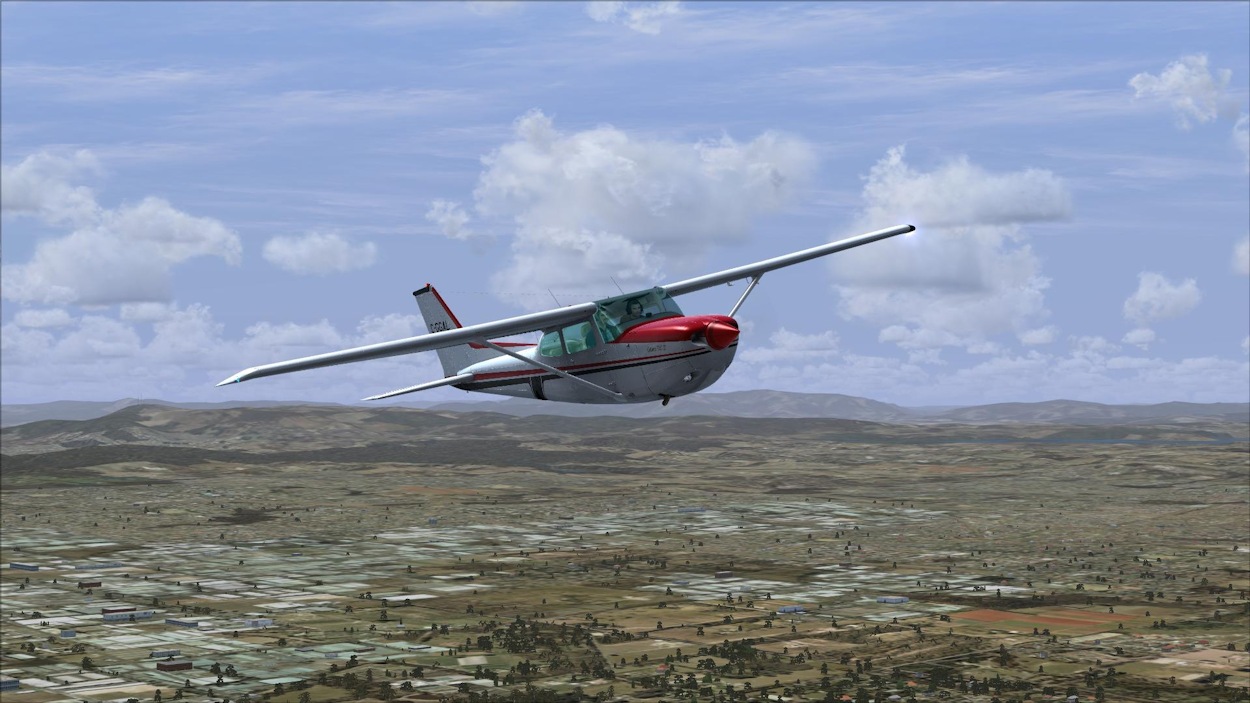 In Flight 1 |
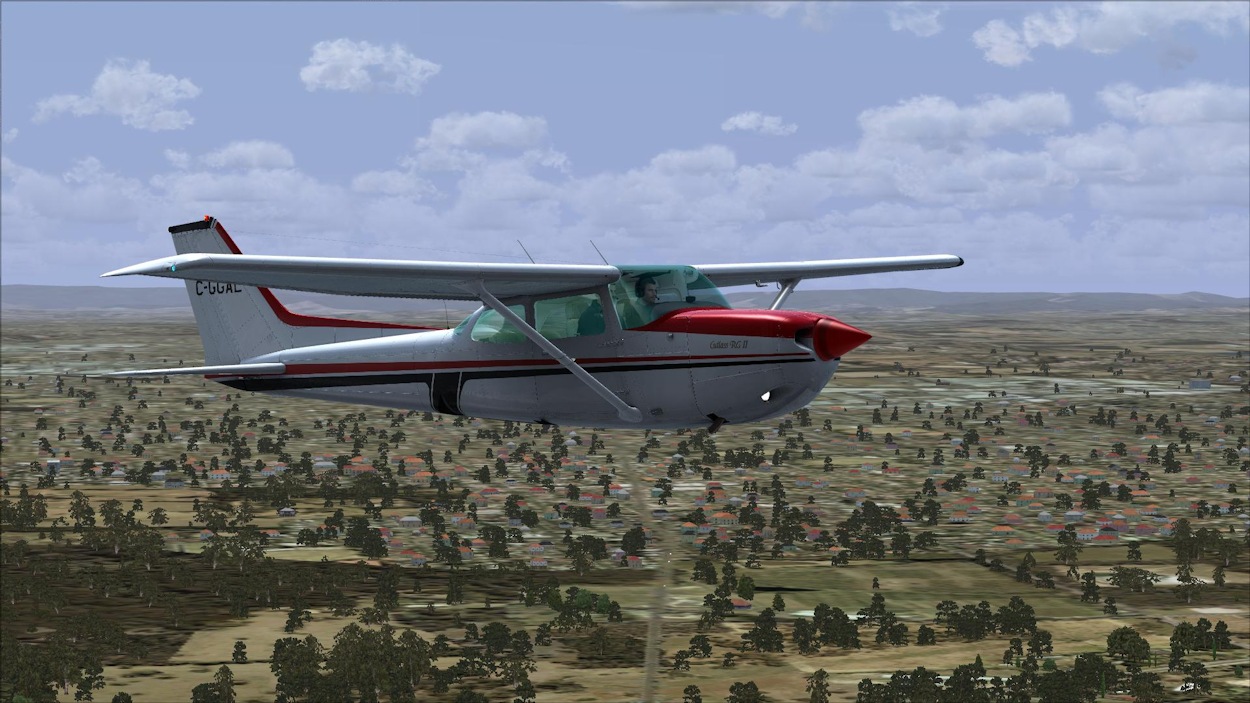 In Flight 2 |
In all, the performance of Alabeo’s Cessna 172RG 'Cutlass II' was excellent in flight, displaying the typical flight characteristics of this aircraft. Overall, the aircraft model displays a very accurate rendition of the flight characteristics and performance of the real world aircraft.
Technical Requirements
This version of the Alabeo Cessna 172RG 'Cutlass II' is for FSX / P3D only. Other specified technical requirements are as follows:
● Windows Vista or Windows 7 (32 or 64bit);
● Microsoft Flight Simulator FSX with SP1 and SP2 (or Acceleration Pack) or Lockheed Martin Prepar3d Flight Simulator installed; and
● Pentium V, 2GHz or similar, 2GB RAM, 512MB graphics card, and 330MB available HDD space.
Simulator Performance
The aircraft model performed very well within the existing settings I have in FSX. I have most of my settings set very high and there was no need to make any adjustments. FSX continued to perform smoothly and as it would with any default aircraft.
Review Computer Specifications
The specifications of the computer on which the review was conducted are as follows:
● Intel i7 990X Extreme 3.46GHz;
● NVidia GTX580, 1536MB graphics;
● 12GB Kingston DDR3 2000MHz;
● Windows 7, (64bit);
● Microsoft Flight Simulator FSX Acceleration; and
● Additional major add-ons include: REX Essential Plus Overdrive; Ultimate Traffic 2; Orbx FTX Global BASE; Orbx FTX Global VECTOR;
Orbx FTX region series; and Orbx FTX airport series.
Conclusion
Alabeo have recreated the Cessna 172RG 'Cutlass II' demonstrating their clear intent of "combining the joy, the challenge, and the fun of flying". Displaying a good balance of quality and detail with a very reasonable price point, Alabeo's 172RG 'Cutlass II' is a great general aviation aircraft and it is great to fly.
Detected issues were minor and do not impact or significantly detract from the general flying of the aircraft. If you are a general aviation and / or Cessna fan in particular, you will want to add this aircraft to your collection.
Verdict
The Cessna 172RG 'Cutlass II' is a solid product from Alabeo which displays a high quality and attention to detail and represents exceptional overall value for money.
Pros:
● Quality and attention to detail;
● Realistic modelling and performance;
● Excellent documentation; and
● Excellent good value for money.
Cons:
● Minor performance variances; and
● Minor lighting effect anomalies.
| Verdict: |
 |
|
| • External Model: | 9.0/10 | |
| • Internal Model: | 9.0/10 | |
| • Sounds: | 8.5/10 | |
| • Flight Characteristics (does it fly by the numbers): | 9.5/10 | |
| • Flight Dynamics (does it feel like what it looks like): | 10/10 | |
| • Documentation: | 10/10 | |
| • Value for money: | 10/10 |
|
The Alabeo Cessna 172RG 'Cutlass II' is awarded an overall Mutley’s Hangar score of 9.4/10, with an "Outstanding" and a Mutley's Hangar Gold Award. |
|
Links Alabeo Home page Cutlass Product page |
| Top |
.jpg)